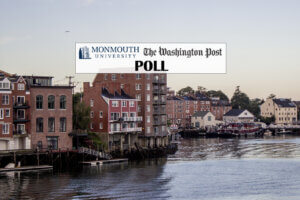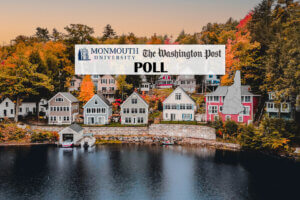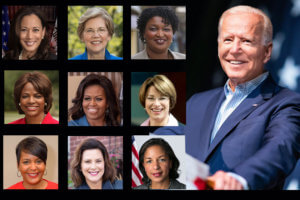West Long Branch, NJ – Support for former South Bend Mayor Pete Buttigieg and Vermont Sen. Bernie Sanders has grown while backing for Massachusetts Sen. Elizabeth Warren and former Vice President Joe Biden has declined in New Hampshire. This makes the latest Monmouth University Poll of the Granite State primary effectively a four-way race right now. The poll also finds that primary voters are divided on whether the current nomination calendar gives all types of Democrats an equal voice in the process. In fact, a plurality would be willing to share their “first-in-the-nation” status.
Among registered New Hampshire Democrats and unaffiliated voters who are likely to participate in the February 2020 Democratic primary, 20% currently support Buttigieg, 19% back Biden, 18% back Sanders, and 15% back Warren. Others registering support include Minnesota Sen. Amy Klobuchar (6%), Hawaii Rep. Tulsi Gabbard (4%), former hedge fund manager Tom Steyer (4%), entrepreneur Andrew Yang (3%), Colorado Sen. Michael Bennet (2%), and New Jersey Sen. Cory Booker (1%). Three other candidates included in the poll (former Massachusetts Gov. Deval Patrick, former Maryland Rep. John Delaney, author Marianne Williamson) earn less than 1%. Another 7% of likely primary voters remain undecided and do not lean toward any candidate choice at this time. [Note: Mike Bloomberg will not appear on the New Hampshire ballot and is not included in this poll.]
Compared to Monmouth’s last New Hampshire poll in September, Buttigieg’s support has grown by 10 points (from 10%) and Sanders’ support has increased by 6 points (from 12%). Warren’s support has dropped by 12 points (from 27%) and Biden’s has decreased by 6 points (from 25%).
“The race remains fairly wide-open. To the extent that New Hampshire voters could take some cues from Iowa, it’s also worth keeping an eye on lower polling candidates like Klobuchar if any of the leading contenders stumble in the earlier Iowa contest,” said Patrick Murray, director of the independent Monmouth University Polling Institute.
Self-described liberals divide their preference among Sanders (26%), Warren (24%), Buttigieg (16%), and Biden (16%). Self-described moderates and conservatives are split between Buttigieg (25%) and Biden (22%). Sanders gets 10% and Warren gets 7% support among non-liberals, placing them at about the same level as Klobuchar (9%), Gabbard (7%), and Steyer (6%) with this bloc.
Among voters under the age of 50, Sanders leads (26%), followed by Buttigieg (17%), Warren (16%) and Biden (15%). Among voters age 65 and over, the battle is between Biden (27%) and Buttigieg (20%), with double-digit backing for Warren (16%) and Sanders (14%) as well.
With the race still in flux, Monmouth analysts ran a variety of different likely voter models in addition to the benchmark results reported in this release. A model that increases the share of lower propensity voters shows Biden, Buttigieg, and Sanders each with 19% support, Warren with 15%, Klobuchar and Gabbard with 5% each, and Steyer and Yang with 4% each. A model that gives more weight to traditional primary voters shows Buttigieg with 23% support, Biden with 20%, Sanders with 16%, Warren with 15%, Klobuchar with 7%, and Gabbard with 4%.
The Monmouth poll also asked New Hampshire voters who they would back if the nomination race came down to just a few candidates by the time of the state’s February 11th primary. No single candidate emerges as a presumptive front-runner in a scenario involving just the four candidates who lead in the poll right now. Biden’s vote share grows by 5 points to 24%, Buttigieg increases 3 points to 23%, Sanders increases 3 points to 21%, and Warren increases 3 points to 18%. Another 5% – half of whom are Gabbard supporters – say they will not vote for any of these candidates in a four-way race.
“There appears to be no natural heir if the field winnows before New Hampshire. Supporters of lower polling candidates tend to disperse fairly evenly among the top contenders,” said Murray.
| 2020 DEMOCRATIC FIELD NEW HAMPSHIRE PARTY VOTER OPINION Net Rating (favorable – unfavorable) | |||
| Jan ’20 | Sept ’19 | May ’19 | |
| Bernie Sanders | +46 | +35 | +54 |
| Pete Buttigieg | +45 | +50 | +47 |
| Elizabeth Warren | +37 | +55 | +39 |
| Andrew Yang | +35 | +5 | –3 |
| Joe Biden | +33 | +42 | +65 |
| Amy Klobuchar | +31 | +22 | +33 |
| Cory Booker | +24 | +31 | +42 |
| Tom Steyer | +15 | +10 | n/a |
| Deval Patrick | –5 | n/a | n/a |
The Monmouth University Poll also asked voters their overall opinion of nine candidates. Sanders currently holds the most positive rating at 69% favorable and 23% unfavorable, which is up from September (63%-28%). Yang’s rating is much better now (53%-18%) than it was in the fall (31%-26%) while Klobuchar’s rating has also ticked up (48%-17% from 41%-19%). Other candidate ratings have slipped, though, including Warren (64%-27% now, from 74%-19% in September), Biden (62%-29% from 66%-24%), and, to a lesser degree, Buttigieg (62%-17% from 62%-12%) and Booker (47%-23% from 49%-18%). Steyer’s net rating has inched up since September (41%-26% from 32%-22%), while Patrick enters the race with a net negative rating of 27% favorable and 32% unfavorable.
There has been a debate over the representativeness of the early contests in the Democratic nomination process. Nationally, the party includes voters with different political views as well as diverse races and ethnicities, while the first contests in Iowa and New Hampshire have almost entirely non-Hispanic white electorates. Granite State primary voters are divided as to whether the current calendar provides adequate representation to the entire party, with 47% saying the calendar gives some types of Democratic voters more influence than others in the party’s presidential nominating process and 38% saying it gives all types of Democrats an equal voice. Self-identified liberals (56%) are more likely than moderates and conservatives (40%) to say that the current calendar gives some types of voters more influence than others.
At the same time, most Granite State primary voters (63%) feel that states like Iowa and New Hampshire have the right amount of influence on who wins the presidential nomination. Another 20% say these states have too much influence while 11% counter that they do not have enough influence over the final outcome. Similarly, 63% say that having Iowa and New Hampshire go first in the nominating process makes little difference one way or the other in the likelihood that the Democratic Party will nominate the best candidate for president. However, 21% say having these states go first makes it more likely that the Democrats will nominate the best candidate while only 9% say it makes this outcome less likely. There are few demographic or voter group differences in this opinion.
A plurality of Granite State primary voters (46%) would be open to the idea of one or two other states holding their presidential primaries on the same day as New Hampshire, while 31% say this would be a bad idea. Liberals (52%) are somewhat more likely than moderates and conservative Democrats (41%) to think that having another state or two vote on the same day as New Hampshire is a good idea.
“New Hampshire’s first-in-the-nation status has taken on a mythic quality. But when you ask voters there about it, few seem willing to back the idea that their position on the calendar necessarily leads to a better outcome overall,” said Murray.
The Monmouth University Poll was conducted by telephone from January 3 to 7, 2020 with 404 New Hampshire voters who are likely to vote in the Democratic presidential primary in February 2020, out of 697 registered voters that were contacted for the poll. The question results in this release have a margin of error of +/- 4.9 percentage points. The poll was conducted by the Monmouth University Polling Institute in West Long Branch, NJ.
QUESTIONS AND RESULTS
(* Some columns may not add to 100% due to rounding.)
1. If the Democratic primary election for president was today, would you vote for [NAMES WERE ROTATED]? [If UNDECIDED: If you had to vote for one of these candidates at this moment, who do you lean toward?]
| TREND: (with leaners) | Jan. 2020 | Sept. 2019 | May 2019 |
| Pete Buttigieg | 20% | 10% | 9% |
| Joe Biden | 19% | 25% | 36% |
| Bernie Sanders | 18% | 12% | 18% |
| Elizabeth Warren | 15% | 27% | 8% |
| Amy Klobuchar | 6% | 2% | 2% |
| Tulsi Gabbard | 4% | 2% | <1% |
| Tom Steyer | 4% | 2% | n/a |
| Andrew Yang | 3% | 2% | 1% |
| Michael Bennet | 2% | 0% | 0% |
| Cory Booker | 1% | 2% | 2% |
| John Delaney | <1% | <1% | <1% |
| Deval Patrick | <1% | n/a | n/a |
| Marianne Williamson | 0% | 1% | <1% |
| (VOL) Other | 0% | 5%* | 11%* |
| (VOL) No one | 0% | 1% | <1% |
| (VOL) Undecided | 7% | 9% | 11% |
| (n) | (404) | (401) | (376) |
* Includes candidates who have since dropped out.
2. If the Democratic nomination came down to the following seven candidates by the New Hampshire primary, who would you vote for? [NAMES WERE ROTATED]
| Jan. 2020 | |
| Joe Biden | 21% |
| Bernie Sanders | 21% |
| Pete Buttigieg | 20% |
| Elizabeth Warren | 15% |
| Amy Klobuchar | 7% |
| Andrew Yang | 5% |
| Cory Booker | 2% |
| (VOL) None of these/won’t vote | 3% |
| (VOL) Undecided | 8% |
| (n) | (404) |
3. And if the Democratic nomination came down to just these four candidates by the New Hampshire primary, who would you vote for? [NAMES WERE ROTATED]
| Jan. 2020 | |
| Joe Biden | 24% |
| Pete Buttigieg | 23% |
| Bernie Sanders | 21% |
| Elizabeth Warren | 18% |
| (VOL) None of these/won’t vote | 5% |
| (VOL) Undecided | 8% |
| (n) | (404) |
4. I’m going to read you the names of some people who are running for president in 2020. Please tell me if your general impression of each is favorable or unfavorable, or if you don’t really have an opinion. If you have not heard of the person, just let me know. [NAMES WERE ROTATED]
| TREND: | Favorable | Unfavorable | No opinion | Not heard of | (n) |
| Former Vice President Joe Biden | 62% | 29% | 10% | 0% | (404) |
| — Sept. 2019 | 66% | 24% | 10% | 0% | (401) |
| — May 2019 | 80% | 15% | 5% | 0% | (376) |
| Vermont Senator Bernie Sanders | 69% | 23% | 7% | 0% | (404) |
| — Sept. 2019 | 63% | 28% | 8% | 1% | (401) |
| — May 2019 | 73% | 19% | 8% | 0% | (376) |
| Massachusetts Senator Elizabeth Warren | 64% | 27% | 9% | 0% | (404) |
| — Sept. 2019 | 74% | 19% | 6% | 1% | (401) |
| — May 2019 | 63% | 24% | 11% | 2% | (376) |
| Minnesota Senator Amy Klobuchar | 48% | 17% | 28% | 7% | (404) |
| — Sept. 2019 | 41% | 19% | 29% | 11% | (401) |
| — May 2019 | 44% | 11% | 25% | 20% | (376) |
| Former South Bend, Indiana Mayor Pete Buttigieg | 62% | 17% | 17% | 4% | (404) |
| — Sept. 2019 | 62% | 12% | 18% | 8% | (401) |
| — May 2019 | 54% | 7% | 19% | 21% | (376) |
| New Jersey Senator Cory Booker | 47% | 23% | 24% | 6% | (404) |
| — Sept. 2019 | 49% | 18% | 27% | 6% | (401) |
| — May 2019 | 54% | 12% | 22% | 13% | (376) |
| Entrepreneur Andrew Yang | 53% | 18% | 25% | 4% | (404) |
| — Sept. 2019 | 31% | 26% | 30% | 13% | (401) |
| — May 2019 | 11% | 14% | 30% | 45% | (376) |
| Former hedge fund manager Tom Steyer | 41% | 26% | 27% | 5% | (404) |
| — Sept. 2019 | 32% | 22% | 33% | 13% | (401) |
| — May 2019 | — | — | — | — | — |
| Former Massachusetts Governor Deval Patrick | 27% | 32% | 34% | 7% | (404) |
| — Sept. 2019 | — | — | — | — | — |
| — May 2019 | — | — | — | — | — |
5. Do you think voters in states like Iowa and New Hampshire have too much influence on who wins the party nominations for president, not enough influence, or about the right amount of influence on who wins the party nominations for president?
| Jan. 2020 | |
| Too much influence | 20% |
| Not enough influence | 11% |
| Right amount of influence | 63% |
| (VOL) Don’t know | 7% |
| (n) | (404) |
6. Do you think having Iowa and New Hampshire go first in the nominating process makes it more likely or less likely that the Democratic Party will nominate the best candidate for president, or do you think having those states go first makes little difference in the likelihood that Democrats will nominate the best candidate?
| Jan. 2020 | |
| More likely | 21% |
| Less likely | 9% |
| Little difference | 63% |
| (VOL) Don’t know | 7% |
| (n) | (404) |
7. Nationally, the Democratic Party includes voters with different political views, races and ethnicities, and other characteristics. Does the current presidential primary calendar give all types of Democratic voters an equal voice in the party’s presidential nomination process or does the calendar give some types of voters more influence than others? [If MORE INFLUENCE: Is that a lot more influence or just a little more?]
| Jan. 2020 | |
| Gives all an equal voice | 38% |
| Some have a lot more influence | 18% |
| Some have a little more influence | 17% |
| Some have more influence, not sure how much | 12% |
| (VOL) Don’t know | 15% |
| (n) | (404) |
8. Do you think it would be a good idea or bad idea to allow one or two other states to hold their presidential primary on the same day as New Hampshire?
| Jan. 2020 | |
| Good idea | 46% |
| Bad idea | 31% |
| (VOL) Depends | 7% |
| (VOL) Don’t know | 15% |
| (n) | (404) |
METHODOLOGY
The Monmouth University Poll was sponsored and conducted by the Monmouth University Polling Institute from January 3 to 7, 2020 with a statewide random sample of 697 New Hampshire voters drawn from a list of registered voters who participated in a primary or general election in the past two election cycles. This includes 313 contacted by a live interviewer on a landline telephone and 384 contacted by a live interviewer on a cell phone, in English. Results are based on 404 voters who are likely to vote in the Democratic presidential primary in February 2020. Monmouth is responsible for all aspects of the survey design, data weighting and analysis. The full sample is weighted for party registration, age, gender, race, and education based on state voter registration list information and U.S. Census information (CPS 2018 supplement). Data collection support provided by Braun Research (field) and Aristotle (voter sample). For results based on the sample of likely Democratic primary voters, one can say with 95% confidence that the error attributable to sampling has a maximum margin of plus or minus 4.9 percentage points (unadjusted for sample design). Sampling error can be larger for sub-groups (see table below). In addition to sampling error, one should bear in mind that question wording and practical difficulties in conducting surveys can introduce error or bias into the findings of opinion polls.
| DEMOGRAPHICS (weighted) |
| Party Registration |
| 58% Democrat |
| 42% None |
| Self-Reported Party |
| 50% Democrat |
| 50% Other, independent |
| 44% Male |
| 56% Female |
| 14% 18-34 |
| 17% 35-49 |
| 33% 50-64 |
| 35% 65+ |
| 95% White, non-Hispanic |
| 5% Other race, Hispanic |
| 46% No degree |
| 54% 4 year degree |
Click on pdf file link below for full methodology and crosstabs by key demographic groups.




